 |
Sergei Rachmaninoff (1873 – 1943) was revered as one of the supreme pianists of his time, yet his music was dismissed as trite, as if little more could be expected of a mere performer. was revered as one of the supreme pianists of his time, yet his music was dismissed as trite, as if little more could be expected of a mere performer.
Such disdain is hard to defend with any sense of history, past or present.  Chopin, Schumann and Liszt, the great pianists of the prior generation – and Mozart and Beethoven before them – all captivated critics and attained lasting fame through sensational concerts of their own acclaimed compositions. Nowadays we celebrate our jazz, folk and rock icons (Duke Ellington, Bob Dylan, the Beatles ...) not just for their distinctive recordings but for the music they wrote. Chopin, Schumann and Liszt, the great pianists of the prior generation – and Mozart and Beethoven before them – all captivated critics and attained lasting fame through sensational concerts of their own acclaimed compositions. Nowadays we celebrate our jazz, folk and rock icons (Duke Ellington, Bob Dylan, the Beatles ...) not just for their distinctive recordings but for the music they wrote.
Rachmaninoff's problem was one of timing – he was brazenly romantic and deeply traditional in an era driven by rapid esthetic progress and dry intellectual exploration. He often stated that music must come from the heart, not the head. Nowadays, when audiences seek respite from the expressive void of most modern serious music, the fact that Rachmaninoff was born a generation too late hardly seems to matter. But in his own time, it surely did. In an oft-quoted example of narrow-minded criticism, the authoritative Groves' Dictionary of Music and Musicians still sniped as late as in its 1954 edition that Rachmaninoff's music was "effective but monotonous in texture" and consisted "in essence mainly of artificial and gushing tunes accompanied by a variety of figures derived from arpeggios. The enormous popular success some few of Rachmaninov's works had in his lifetime is not likely to last." 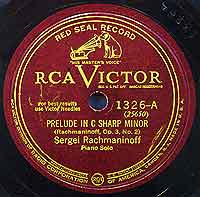 (In its current 2001 edition, Groves made partial amends by thoroughly refuting its own prior assessment: "He used his own standing as a performer not to write music of unreasonably empty virtuosity but rather to explore fully the expressive possibilities of his instrument. … At its most inspired, Rachmaninoff's lyrical inspiration is matchless." Even the textures, formerly damned as "monotonous," now were hailed as "subtly varied" and "carefully contrasted.") (In its current 2001 edition, Groves made partial amends by thoroughly refuting its own prior assessment: "He used his own standing as a performer not to write music of unreasonably empty virtuosity but rather to explore fully the expressive possibilities of his instrument. … At its most inspired, Rachmaninoff's lyrical inspiration is matchless." Even the textures, formerly damned as "monotonous," now were hailed as "subtly varied" and "carefully contrasted.")
For someone seemingly so old-fashioned, Rachmaninoff had a highly unconventional career. After receiving the highest marks ever awarded by the Moscow Conservatory and intensive piano training with Nikolai Sverov, a strict disciplinarian who closeted his students in his home for five years of rigorous study, Rachmaninoff soared to fame at age 19 with his Prelude in c-sharp minor, a remarkably haunting four-minute slice of chromatic yearning, for which audiences would gladly sit through an entire recital to hear as the inevitable encore. While a welcome professional jump-start for an unknown student, Rachmaninoff later came to regret that this novice work eclipsed all his mature and more substantial output.
 Along with recitals of his own work, in 1897 Rachmaninoff launched a conducting career, first at an opera company newly formed by a railway magnate, and then at the Bolshoi Opera, where he specialized in Russian repertoire. (Such moves are hardly unusual – celebrated pianists from Mendelssohn to Bernstein, Previn and Ashkenazy traded their keyboards for batons.) Without formal training he learned his role intuitively, achieving consistent success with all operas except his own. In 1905 he launched a series of orchestral concerts, to which he devoted his full attention beginning the next year. Along with recitals of his own work, in 1897 Rachmaninoff launched a conducting career, first at an opera company newly formed by a railway magnate, and then at the Bolshoi Opera, where he specialized in Russian repertoire. (Such moves are hardly unusual – celebrated pianists from Mendelssohn to Bernstein, Previn and Ashkenazy traded their keyboards for batons.) Without formal training he learned his role intuitively, achieving consistent success with all operas except his own. In 1905 he launched a series of orchestral concerts, to which he devoted his full attention beginning the next year. 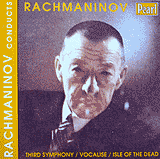 Barrie Martyn describes his conducting manner as precise and demanding and his podium style as only outwardly placid, with intensity grounded in mental poise, inner calm and control. Known for his restrained gestures, Rachmaninoff explained that it requires great strength to be quiet. Above all other conductors of his time he revered Mahler, whose preparation impressed him with his extreme attention to detail. Barrie Martyn describes his conducting manner as precise and demanding and his podium style as only outwardly placid, with intensity grounded in mental poise, inner calm and control. Known for his restrained gestures, Rachmaninoff explained that it requires great strength to be quiet. Above all other conductors of his time he revered Mahler, whose preparation impressed him with his extreme attention to detail.
Rachmaninoff's repertoire was varied but unlike most conductors he never lapsed into a rut of repeating a relative handful of favorites. Indeed, in Martyn's list of his lifetime repertoire, only seven works, aside from his own, received three or more performances – Grieg's Peer Gynt Suite # 1, Liszt's Piano Concerto # 1 and Totentanz, Moussorgsky's Night on Bald Mountain and the "Gopak" from his Sorochinsky Fair, and Tchaikovsky's Piano Concerto # 1 and Symphony # 5. His only recordings as a conductor were of his own Isle of the Dead and an orchestral arrangement of the brief Vocalise (both in 1929) and Symphony # 3 (1939), all with the Philadelphia Orchestra. Surging with straightforward power, he presents his work with unadorned elemental force that redresses their sprawling, diffuse structures.
 Rachmaninoff resumed his career as a recitalist out of practical rather than artistic compulsion. Since 1906 he had focused on composing and giving concerts of his own work, but the Russian Revolution brought a suspension of public concerts, threatened to erode the values he cherished and threw his future into doubt. After a tour of Scandinavia, he emigrated to the United States, arriving on Armistice Day. Based on his reputation (fostered during a prior 1909 visit), Rachmaninoff was welcomed with offers from managers, piano manufacturers, record companies and orchestras, including the helms at Boston and Cincinnati. Rachmaninoff resumed his career as a recitalist out of practical rather than artistic compulsion. Since 1906 he had focused on composing and giving concerts of his own work, but the Russian Revolution brought a suspension of public concerts, threatened to erode the values he cherished and threw his future into doubt. After a tour of Scandinavia, he emigrated to the United States, arriving on Armistice Day. Based on his reputation (fostered during a prior 1909 visit), Rachmaninoff was welcomed with offers from managers, piano manufacturers, record companies and orchestras, including the helms at Boston and Cincinnati. 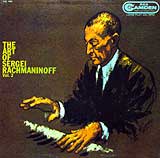 Instead, to support his family he chose to focus on a solo career and began intensive work to build recital programs, adding up to several dozen new pieces each year. Most great pianists begin playing the established repertoire as child prodigies, so their ripest years reflect decades of study, familiarity and refinement. Rachmaninoff, though, was in his mid-forties before he turned to the work of others. Instead, to support his family he chose to focus on a solo career and began intensive work to build recital programs, adding up to several dozen new pieces each year. Most great pianists begin playing the established repertoire as child prodigies, so their ripest years reflect decades of study, familiarity and refinement. Rachmaninoff, though, was in his mid-forties before he turned to the work of others.
An N. Weinberg, writing in the Washington Herald, had noted: "Composers seldom play well. Absorbed by their own creative work, they seldom have time or inclination for painstaking, conscientious recreation of other men's works." Yet, Sergei Bertensson and Jay Leyda state: "All the demands he made on himself in playing his own compositions were multiplied in playing the work of others." Bringing to his performances the mind of a composer, Rachmaninoff insisted upon deconstructing each work he played to discover and gain a profound understanding of its essence. Colleagues recall that he would learn a new piece by playing it up to twenty times slower than written and sounding each chord repeatedly up and down the keyboard. Harold Schonberg called him the great builder, who emphasized the architectural splendor and inexorable logic in each piece through a colossal technique in which rhythmic thrust, sonority and phrasing were shaped with virility and exquisite finish. Abram Chasins recalled him as an incessant perfectionist whose playing focused on the distribution of balances within chords. Rachmaninoff insisted that each piece had a "point," a mystical culmination (not necessarily the climax) upon which all its elements converged and toward which the depth and power of each sound carefully but naturally was calculated to lead. When he felt that he had missed the "point" in one of his renditions Rachmaninoff would sink into a deep, inconsolable depression for up to several days. 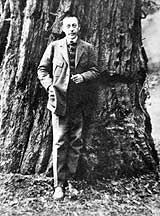
Olin Downes left us a vivid description of the distinctive intensity of a 1935 New York recital:
The bell rings and a very tall, spare, grave gentleman, in afternoon garb of irreproachable correctness and sobriety, steps without smiling upon the stage. He seats himself at the piano and plays. He does not smile once through the whole occasion. In no way does he gesticulate or parade. All that he communicates he says with two wrists and ten fingers, without the raising of an eyebrow. The performance is one of mind sovereign over matter, spirit that transfigures digital gymnastics. So it has always been with Rachmaninoff, and so it will be for the years to come. It is his fine tribute to art.
Rachmaninoff refused to participate in any radio broadcasts: "One shouldn't be too comfortable when listening to really good music. To appreciate good music one must be mentally alert and emotionally receptive. You can't be that when you are sitting at home with your foot on a chair." Yet, he apparently had no such misgivings for recordings, in part due to their superior sonic quality and his ability to correct mistakes prior to release. Fortunately, Rachmaninoff's art is preserved in about eight hours of solo recordings. Unfortunately, though, the vast majority are the short and occasionally trite pieces that routinely served as concert encores but which record companies pushed their rosters of artists to record as the 78 rpm "singles" of the time in lieu of more substantial fare. Indeed, Rachmaninoff urged Victor, with whom he had an exclusive contract after a brief stint with Edison, to record several of his complete recital programs, but they declined. While we can bemoan the loss of the Liszt, Scriabin and 13 Beethoven sonatas he often played to great acclaim, we do have an hour of his brilliantly inventive Chopin and two major works that amply illustrate the commentators' praise of his artistry.
The first is Schumann's Carnival, essentially a set of short character pieces. Rachmaninoff shapes each element with full regard to its vibrant, free-wheeling intrinsic spirit as well as its place in the whole.  Most intriguing, though, is his treatment of the "Sphinxes" movement, consisting in its entirety of three related motifs written as double whole notes (but in the square shape of early notation), which most pianists assume, consistent with the title, to be a puzzle that mystically informs the work but that should be hidden and silent. (The third, shown at the right, spells out the name of his girl's home town in German nomenclature.) Rachmaninoff, though, plays them as rumbling tremeloes that give the entire work a spooky, somber undercurrent. (Among the many other pianists who have recorded Carnival, Cortot plays the "Sphinxes" as long, held notes, just as they are notated.) Most intriguing, though, is his treatment of the "Sphinxes" movement, consisting in its entirety of three related motifs written as double whole notes (but in the square shape of early notation), which most pianists assume, consistent with the title, to be a puzzle that mystically informs the work but that should be hidden and silent. (The third, shown at the right, spells out the name of his girl's home town in German nomenclature.) Rachmaninoff, though, plays them as rumbling tremeloes that give the entire work a spooky, somber undercurrent. (Among the many other pianists who have recorded Carnival, Cortot plays the "Sphinxes" as long, held notes, just as they are notated.)
Perhaps most remarkable is Rachmaninoff's transformative exploration of Chopin's Sonata # 2, Op. 35. Rachmaninoff completely reframes the dynamics of the tumultuous opening movement, reflecting the Russian tendency to emphasize musical climaxes by restraining the volume rather than pounding away, and he shapes the central più lento section of the scherzo with striking rhythmic flexibility. But the most startling interpretive transformation comes with the Marche funèbre third movement. After the well-known somber death march and a central section of surpassing tenderness, the score specifies that the march return pianissimo (very softly). Rachmaninoff, though, plunges into the return of the funeral march with shattering volume and then slowly descends to the end. His bold gesture shifts the perspective away from one of gentle death lulled by human beauty toward a grim vision of indomitable fate, utterly unmoved by hope or prayer. 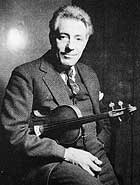 The aura is driven home by the brief final movement, written as a dense fabric of breathless onrushing triplets, from which Rachmaninoff constantly extracts threads of turbulent emotional upheaval to craft an unsettling vision of the confused human condition, and thus injects astonishing subliminal insight to revitalize a familiar war-horse. The aura is driven home by the brief final movement, written as a dense fabric of breathless onrushing triplets, from which Rachmaninoff constantly extracts threads of turbulent emotional upheaval to craft an unsettling vision of the confused human condition, and thus injects astonishing subliminal insight to revitalize a familiar war-horse.
Rachmaninoff also recorded three substantial duets with Fritz Kreisler in 1928 – the Grieg Sonata # 3 in c-minor, the Beethoven Sonata # 8 in G and the Schubert Sonata # 5 in A. Rachmaninoff recalled that Kreisler was an optimist who was constantly thrilled with the beautiful music he created, whereas he was a pessimist, who always felt they could do better. Although the recording balance favored Kreisler, whom the producers clearly considered the brighter star, Rachmaninoff apparently got his way, as they cut multiple takes of each side. The music is enriched by a pervasive tension between artists of such different temperaments, and the whole seems far greater than a tug of war between the two disparate parts.
Finally, we should note Rachmaninoff’s Ampico piano rolls recorded between 1919 and 1929. Although punched on long spools of paper, this was a far more sophisticated technology than the uniform clattering of “player piano” rolls; when reproduced properly on playback apparatus they reveal not only the notes but their volume and pedaling, and thus much of the nuance – and all the fidelity – only partially captured on 78s. Aside from six pieces he recorded only on rolls ranging from significant (the Chopin Scherzo #2) to trivial (the “Star Spangled Banner”), all duplicate repertoire Rachmaninoff recorded conventionally and the interpretations are barely distinguishable, although earlier rolls do have slightly finer shading than later discs. Yet the sheer sonic quality truly does invoke a sense of the depth and polish that audiences actually heard and praised in live Rachmaninoff performances. Selections are available on A Window in Time, a 1998 pair of Telarc CDs, and in somewhat brighter transfers on a single Decca CD.
 Although the impact of recordings undoubtedly is shifting our perception, multitalented artists of the past are remembered by their concrete compositions while memories of their ephemeral performances have faded. Thus, despite his splendor and reputation in his time as a conductor and pianist, and despite the views of dissenting critics, it is as a composer that Rachmaninoff is now best known. (Interestingly, other great pianists of Rachmaninoff's time also turned to composing as a creative outlet to their primary careers, but with far different goals – Artur Schnabel and Josef Hoffman (under the assumed name of Michel Dvorsky) wrote in a decidedly modern idiom, perhaps as a complement to the traditional focus of their concert work.) Martyn divides Rachmaninoff's unusual career as a composer into three periods. During the first his work was derivative and full of empty rhetoric, unable to emerge from the vast shadow of Tchaikovsky. In the third, uprooted after the Bolshevik Revolution, he became austere and abstract, with nostalgia replacing true feeling and his energies largely sapped by the pressure of concertizing. It was in his second period during his middle two decades that his invention blossomed and expressive range enlarged, memorable melodies and deepened feeling. Although the impact of recordings undoubtedly is shifting our perception, multitalented artists of the past are remembered by their concrete compositions while memories of their ephemeral performances have faded. Thus, despite his splendor and reputation in his time as a conductor and pianist, and despite the views of dissenting critics, it is as a composer that Rachmaninoff is now best known. (Interestingly, other great pianists of Rachmaninoff's time also turned to composing as a creative outlet to their primary careers, but with far different goals – Artur Schnabel and Josef Hoffman (under the assumed name of Michel Dvorsky) wrote in a decidedly modern idiom, perhaps as a complement to the traditional focus of their concert work.) Martyn divides Rachmaninoff's unusual career as a composer into three periods. During the first his work was derivative and full of empty rhetoric, unable to emerge from the vast shadow of Tchaikovsky. In the third, uprooted after the Bolshevik Revolution, he became austere and abstract, with nostalgia replacing true feeling and his energies largely sapped by the pressure of concertizing. It was in his second period during his middle two decades that his invention blossomed and expressive range enlarged, memorable melodies and deepened feeling.
Rachmaninoff's mature compositions reflected a distinctive but complex personality. Abram Chasins described his forbidding manner and gaunt face behind which he remained largely aloof from the world (although he loved the circus and Jack Benny).  To Harold Schonberg his tall, lanky figure, with its dour, seamed face and close-cropped hair, evoked an escaped convict. Stravinsky called him a "six and a half foot scowl." He had no interest in interviews, teaching or publicity. Yet as Martyn notes, his front to the world concealed his essence – only in music did he express his innermost soul. John Culshaw lauds him as one of the most sincere and unassuming musicians who ever lived, as he remained unflinchingly true to his ideals. To Harold Schonberg his tall, lanky figure, with its dour, seamed face and close-cropped hair, evoked an escaped convict. Stravinsky called him a "six and a half foot scowl." He had no interest in interviews, teaching or publicity. Yet as Martyn notes, his front to the world concealed his essence – only in music did he express his innermost soul. John Culshaw lauds him as one of the most sincere and unassuming musicians who ever lived, as he remained unflinchingly true to his ideals.
Rachmaninoff believed that the mission of music is to give tonal expression to feelings. Although his compositions were widely disparaged by the progressive establishment, audiences enthusiastically embraced his refusal to abandon 19th century traditions and with good reason – as Arnold Schönberg, who led the 20th century escape from traditional tonality, said: "There is still plenty of music to be written in C Major." Charles Koechelin agreed: "One of the worst sicknesses of our time is the desire to be modern. What is necessary is to follow through an idea … free from any fear of resembling – but in return daring to go ahead by unknown roads when there is a need to do so."
The epitome of Rachmaninoff's ideals, and his most popular work, is his 1901 Piano Concerto # 2 in c minor, but it came only after an inauspicious start to his career as a composer. His first piano concerto, written when he was 17, was performed once and never published. (The version we hear today was thoroughly reworked 25 years later.) His next major orchestral work, the 1895 Symphony # 1, was an abject failure. The influential critic César Cui savaged it as having come from a Conservatory in Hell. Tanayev (head of the Moscow Conservatory from which Rachmaninoff had graduated with such high honors) called the melodies "flabby and colorless." The most charitable review was from Nikolai Findeisen, who dubbed it "the product of a composer who has not yet fully found himself" and suggested that the audience misunderstood and underestimated it due to a poor interpretation. Rachmaninoff agreed that the conductor had felt nothing (and even may have been drunk), but went on to suggest that since the music was unfamiliar the audience tended to blame the composer.
The Symphony # 1 was never again performed during his life. Although Rachmaninoff intended to revise the score, he never did, leaving it behind when he left Russia and writing it off at the time as a product of his youthful arrogance – "weak, childish, strained and bombastic" and "very badly orchestrated." After his death it was reconstructed in 1945 from a two-piano transcription and a set of archival orchestral parts and has since become moderately popular.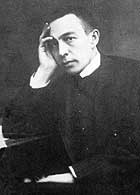 Robert Simpson raises an intriguing possibility: had the premiere been a success or had Rachmaninoff been more able to withstand the shock of its failure, it could have served as the prototype of a more novel and bracing personal style that he seemed to be on the verge of developing in lieu of the less challenging direction his work ultimately took. Robert Simpson raises an intriguing possibility: had the premiere been a success or had Rachmaninoff been more able to withstand the shock of its failure, it could have served as the prototype of a more novel and bracing personal style that he seemed to be on the verge of developing in lieu of the less challenging direction his work ultimately took.
But instead, Rachmaninoff was devastated: "My dreams of a brilliant career lay shattered. My hopes and confidence were destroyed. … I felt like a man who had suffered a stroke and for a long time had lost the use of his head and hands." Only after several years did he emerge from the depths of his apathy by the hand of a Dr. Nikolas Dahl, a local hypnotherapist and musical enthusiast who patiently restored his confidence. Although Rachmaninoff described the treatment as constant repetition of positive encouragement, David Fanning suggests that it had as much to do with the joy of conversing with a cultured man – and the doctor's wife recalled that Rachmaninoff may have been enamored of their daughter. (The next year, though, Rachmaninoff married his cousin, for which the Czar's personal consent was required.) In any event, the therapy was a success and Rachmaninoff's creative juices began to flow – he wrote the second and third movements of a new piano concerto in the summer and autumn of 1900. Bolstered by their successful premiere that December, he completed the work in 1901. While we may never know for sure what transpired during the sessions with Dr. Dahl, Rachmaninoff emerged from his doldrums with a gorgeous, vibrant work that spoke with a distinctive personality (and which he dedicated to Dr. Dahl). And although written in the minor keys which he consistently favored, it's his only major work that escapes quotation of the Dies Irae, the ancient lament for the dead with which he had a life-long obsession.
The opening of the Piano Concerto # 2 announces its character with striking immediacy.  Deep resonant piano chords evoke both the Russian church bells of Rachmaninoff's roots and his complex personality – the outer notes remain steadfast while the inner notes subtly change the harmony, as if to suggest the emotion surging within the composer's somber outward appearance. Since the opening chords would sound thoroughly ineffective if orchestrated or played on any other instrument, they further serve to announce at the outset the piano's essential role in the overall plan of the piece. The supremacy of the piano is confirmed as it continues with a blizzard of notes that thickens the texture of an ensuing luxuriant string melody. Indeed, throughout the entire work, the solo instrument rarely falls silent or cedes the spotlight to the orchestra, leaving no doubt that the composer was at heart a pianist. Deep resonant piano chords evoke both the Russian church bells of Rachmaninoff's roots and his complex personality – the outer notes remain steadfast while the inner notes subtly change the harmony, as if to suggest the emotion surging within the composer's somber outward appearance. Since the opening chords would sound thoroughly ineffective if orchestrated or played on any other instrument, they further serve to announce at the outset the piano's essential role in the overall plan of the piece. The supremacy of the piano is confirmed as it continues with a blizzard of notes that thickens the texture of an ensuing luxuriant string melody. Indeed, throughout the entire work, the solo instrument rarely falls silent or cedes the spotlight to the orchestra, leaving no doubt that the composer was at heart a pianist.
Rachmaninoff's career as a full-time recitalist took a heavy toll on his composing. Of his 45 published works, all but six were written during the first half of his career. Following emigration and a seven-year lull, he would produce a fourth piano concerto, a third symphony and his hugely popular Rhapsody on a Theme of Paganini. Only the last would recover the fresh emotional impulse and sheer wonder of the Second Concerto, in which the composer stepped out from his stifling gloom into eternal sunlight. John Culshaw, for one, considers him a miniaturist, citing the scope, variety, concentration and consistent high quality of his songs and short piano pieces (including 23 more preludes – one in each other key to complement the first in c-sharp minor) that fully exploit the piano's range and gratify performers by lying comfortably under a pianist's hands. Culshaw and many others feel that the moments of beauty and inspiration in his longer forms, while excitingly presented, are diffused with meandering development that stretches the material too thin. The composer may have recognized this – while when pressed by Eugene Ormandy for edits in his Second Symphony he sanctioned only two measures, claiming that any more would be "like cutting a piece out of my heart," Rachmaninoff himself played and recorded his Third Concerto, which he claimed as his favorite, only in a heavily cut version.
Of all our recordings of Rachmaninoff's Piano Concerto # 2,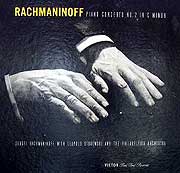 by far the most important is his own, cut with Leopold Stokowski and his Philadelphia Orchestra in April 1929. (Actually, the 1929 set was an electrical remake of the same forces' 1924 acoustical set with a curious history. Although the final two movements were cut in January 1924 and released that May, the first movement was recorded only in December but never issued (and the last of the three sides is lost) – a shame, since, despite thinner sonics, the earlier venture boasted a more sensitive interpretation.) Although nearly three decades had passed since its conception, and his approach undoubtedly had evolved, Rachmaninoff's superlative solo work projects an exquisite feeling of spontaneity, and his elastic phrasing and rhythmic freedom suggest an inspired improvisation, made all the more wondrous by the superb balance and close interplay with the orchestra, which leans into the music without ever wholly succumbing. Indeed, the overall aura is one of neutrality in the best sense – leaving the piece wide open for others to interpret without suggesting that its authenticity should be confined to a single idiomatic style. Michael Steinberg saw this approach as reflecting Rachmaninoff's essential nobility of mind and spirit, and a warning to others to refrain from using his work as a vehicle for vulgar display. Indeed, the composer's playing is far too personal for others to emulate directly, yet its inventiveness encourages successors to apply their own emotional insight. by far the most important is his own, cut with Leopold Stokowski and his Philadelphia Orchestra in April 1929. (Actually, the 1929 set was an electrical remake of the same forces' 1924 acoustical set with a curious history. Although the final two movements were cut in January 1924 and released that May, the first movement was recorded only in December but never issued (and the last of the three sides is lost) – a shame, since, despite thinner sonics, the earlier venture boasted a more sensitive interpretation.) Although nearly three decades had passed since its conception, and his approach undoubtedly had evolved, Rachmaninoff's superlative solo work projects an exquisite feeling of spontaneity, and his elastic phrasing and rhythmic freedom suggest an inspired improvisation, made all the more wondrous by the superb balance and close interplay with the orchestra, which leans into the music without ever wholly succumbing. Indeed, the overall aura is one of neutrality in the best sense – leaving the piece wide open for others to interpret without suggesting that its authenticity should be confined to a single idiomatic style. Michael Steinberg saw this approach as reflecting Rachmaninoff's essential nobility of mind and spirit, and a warning to others to refrain from using his work as a vehicle for vulgar display. Indeed, the composer's playing is far too personal for others to emulate directly, yet its inventiveness encourages successors to apply their own emotional insight.
Many did. This becomes immediately apparent from their treatment of the opening. The score (shown above) specifies a regular rhythm in which each of the first seven measures contains one whole note chord and one bass half-note. Of the artists noted below, some play the passage as written, but others alter the relentless rhythm, add notes or arpeggiate the chords. And little wonder – Rachmaninoff departs from his very own score by playing each half-note as a dotted quarter followed by a wholly new eighth note! Not only that – the score indicates a duration of 34 minutes, while Rachmaninoff's own recording runs to a mere 31.
Of many LP and CD transfers of Rachmaninoff's own recording through the years, two warrant particular attention for the light they shed on the art of transfers, as they contrast the work of two giants in that field. Ward Marston engineered the award-winning 1992 BMG Rachmaninoff Edition with a dry, crisp sound that reflects published descriptions of Rachmaninoff's ascetic style. Mark Obert-Thorn provided Naxos with a much warmer acoustic that evokes more of the composer's internal passion, as well as the rich sonic blend of the Philadelphians. While I prefer the Naxos sound, neither is "correct"; rather, both enrich our understanding of a complex artist.
Of the many dozen recordings of the Second that followed, we have only two by pianists whom Rachmaninoff was known to have admired. 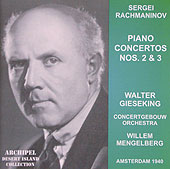 The first is a 1940 concert by Walter Gieseking with the Concertgebouw Orchestra led by Willem Mengelberg. Known to his detractors as "Mangleberg," this conductor never let a score stand in the way of his own inclination and here he liberally recasts tempos, phrasing and dynamics to produce a hugely dramatic and deeply personal reading that sidesteps much of the work's inherent subtlety to drive home the structure in a schematic but undeniably effective way (i.e.: volume and tempo increase for climaxes). Unfortunately, we have no other Gieseking Rachmaninoff recordings (other than a Mengelberg/Concertgebouw concert of the Third Concerto) for comparison, so it's unclear whether this reflects his own approach or accommodation to a strong-willed conductor. Although he adds a bravura chord to the end of the third-movement cadenza, little of his trademark poetry (nor Mengelberg's characteristic orchestral coloration) is evident. Indeed, it's hard to reconcile his heated display with the sensitive artist we know from his renowned Mozart and Debussy recordings. The boldly impassioned performance takes huge risks, and not all of them seem to work, but heard live this must have been a truly thrilling experience, and its frightening intensity for modern ears is abetted by the fierce sonics of the recording. The first is a 1940 concert by Walter Gieseking with the Concertgebouw Orchestra led by Willem Mengelberg. Known to his detractors as "Mangleberg," this conductor never let a score stand in the way of his own inclination and here he liberally recasts tempos, phrasing and dynamics to produce a hugely dramatic and deeply personal reading that sidesteps much of the work's inherent subtlety to drive home the structure in a schematic but undeniably effective way (i.e.: volume and tempo increase for climaxes). Unfortunately, we have no other Gieseking Rachmaninoff recordings (other than a Mengelberg/Concertgebouw concert of the Third Concerto) for comparison, so it's unclear whether this reflects his own approach or accommodation to a strong-willed conductor. Although he adds a bravura chord to the end of the third-movement cadenza, little of his trademark poetry (nor Mengelberg's characteristic orchestral coloration) is evident. Indeed, it's hard to reconcile his heated display with the sensitive artist we know from his renowned Mozart and Debussy recordings. The boldly impassioned performance takes huge risks, and not all of them seem to work, but heard live this must have been a truly thrilling experience, and its frightening intensity for modern ears is abetted by the fierce sonics of the recording.
The second is by Benno Moiseiwitsch (1890 – 1963)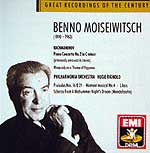 and the Philharmonia Orchestra conducted by Hugo Rignold (EMI, 1955). Rachmaninoff reportedly considered Moiseiwitsch to be his artistic heir and respected his playing for its restraint. Elegant, tasteful, sweet and with lovely phrasing, Moiseiwitsch emerges from an emotional blanket in the second movement, in whose gentle lyricism he seems most comfortable, and extends the mood through an especially sensitive finale, while letting the orchestra generate most of the character, including a few quirks, such as unusually prominent wind solos in the first movement, braying horns in the second and a bizarre halt before rehearsal number 28 in the finale. Overall, the result is relatively free of any distinctive personal touches and remarkable for its pervasive modesty. and the Philharmonia Orchestra conducted by Hugo Rignold (EMI, 1955). Rachmaninoff reportedly considered Moiseiwitsch to be his artistic heir and respected his playing for its restraint. Elegant, tasteful, sweet and with lovely phrasing, Moiseiwitsch emerges from an emotional blanket in the second movement, in whose gentle lyricism he seems most comfortable, and extends the mood through an especially sensitive finale, while letting the orchestra generate most of the character, including a few quirks, such as unusually prominent wind solos in the first movement, braying horns in the second and a bizarre halt before rehearsal number 28 in the finale. Overall, the result is relatively free of any distinctive personal touches and remarkable for its pervasive modesty.
Another favorite artist (and fellow Russian expatriate) was Vladimir Horowitz (1904 – 1989), with whom in his final years Rachmaninoff often played duets in private for their own pleasure. Alas, Horowitz never recorded the Second. Above all others in the composer's esteem was his contemporary Josef Hoffmann (1876 – 1957), who returned the compliment by proclaiming Rachmaninoff to be his favorite pianist but rarely played any of Rachmaninoff's music, not even the Third Concerto, which was dedicated to Hoffman, but which he never performed. His 1923 recordings of two Rachmaninoff preludes display aristocratic confidence, extraordinary control and colorful sonority that would have demanded an especially reticent yet sensitive complementary accompaniment for a convincing rendition of the Second Concerto.
We do have a recording by one of Rachmaninoff's very few pupils. 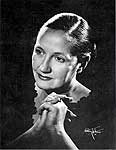 Although Gina Bachauer (1913 – 1976) was famed as a romantic virtuoso, little of that is evident in her respectful 1972 reading with the Strasbourg Philharmonic under Alain Lombard (Erato LP). Although she takes considerable liberties in rhythm and phrasing, she provides a fundamentally gentle and modest commentary on the forceful dynamics and surging climaxes of the orchestral edifice. The aura is enhanced by the recorded balance, which generally pushes her into the background. In any event, her performance makes no attempt to embrace the work as her own and, as with Moiseiwitsch, the most impressive moments come in the soft second movement. Although Gina Bachauer (1913 – 1976) was famed as a romantic virtuoso, little of that is evident in her respectful 1972 reading with the Strasbourg Philharmonic under Alain Lombard (Erato LP). Although she takes considerable liberties in rhythm and phrasing, she provides a fundamentally gentle and modest commentary on the forceful dynamics and surging climaxes of the orchestral edifice. The aura is enhanced by the recorded balance, which generally pushes her into the background. In any event, her performance makes no attempt to embrace the work as her own and, as with Moiseiwitsch, the most impressive moments come in the soft second movement.
Far more interesting  is an inspired 1948 recording (Columbia LP) by Cyril Smith, an acquaintance of the composer. A fervent driven opening leads to exquisitely smooth transitions among impulsively thrusting climactic sections and tender caresses of the softer portions in which each phrase is carefully and individually shaped. The second movement is deeply affecting, as the piano adds sparkling color to enliven the events that culminate in a logical yet soft-spoken climax, suggesting an improvisatory stream of consciousness rather than a dutiful reading of the score. Malcolm Sargent and the Liverpool Philharmonic provide a wonderfully empathetic accompaniment throughout. is an inspired 1948 recording (Columbia LP) by Cyril Smith, an acquaintance of the composer. A fervent driven opening leads to exquisitely smooth transitions among impulsively thrusting climactic sections and tender caresses of the softer portions in which each phrase is carefully and individually shaped. The second movement is deeply affecting, as the piano adds sparkling color to enliven the events that culminate in a logical yet soft-spoken climax, suggesting an improvisatory stream of consciousness rather than a dutiful reading of the score. Malcolm Sargent and the Liverpool Philharmonic provide a wonderfully empathetic accompaniment throughout.
Needing some rational means to cull among dozens of recordings of the Second, and recognizing that Rachmaninoff was 28 when he completed it, I've limited the remainder of this survey to personal favorites made by pianists within a decade or so of the composer's own age – and even then, I've passed over quite a few.
My personal pick among all the ones I've heard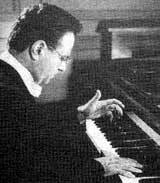 is by Julius Katchen (32 at the time) and Georg Solti conducting the London Symphony (1958, Philips – a remake of his 1949 account with Fistoulari), although it would be dangerous to come to know the work through this reading. From the opening chords, in which Katchen constantly varies the rhythm, we know we're in for a bumpy but thrilling ride. In keeping with that iconoclastic entry, the music surges relentlessly and throbs with the vitality of discovery and exploration, as breakaway moments with wild tempos fueled by biting brass accents smoothly meld into exquisitely sensitive solo passages of breathtaking intimacy. While some may view this romp as quirky and self-indulgent, I find it heartfelt and exhilarating, recalling much of the spontaneous feel of the composer's own recording. Katchen and Solti reconceive the work to make it their own – just as Rachmaninoff did when playing the work of others. Surely he would have approved! is by Julius Katchen (32 at the time) and Georg Solti conducting the London Symphony (1958, Philips – a remake of his 1949 account with Fistoulari), although it would be dangerous to come to know the work through this reading. From the opening chords, in which Katchen constantly varies the rhythm, we know we're in for a bumpy but thrilling ride. In keeping with that iconoclastic entry, the music surges relentlessly and throbs with the vitality of discovery and exploration, as breakaway moments with wild tempos fueled by biting brass accents smoothly meld into exquisitely sensitive solo passages of breathtaking intimacy. While some may view this romp as quirky and self-indulgent, I find it heartfelt and exhilarating, recalling much of the spontaneous feel of the composer's own recording. Katchen and Solti reconceive the work to make it their own – just as Rachmaninoff did when playing the work of others. Surely he would have approved!
Leonard Bernstein,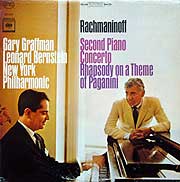 whose ceaseless vitality belied his middle age at the time, led two similar accounts with youthful pianists and an atypically lush-sounding New York Philharmonic. A 1964 record with Gary Graffman (36) features an especially thrilling finale, often considered the weakest movement and, despite a gorgeous melody, somewhat of a letdown after the splendors of the first two. A 1960 LP with Philippe Entremont (26) is even more surging, brash and impulsive, largely ignoring the expressive markings in the score and constantly pushing for maximum volume in lieu of Rachmaninoff's finely-graded dynamics. Indeed, it's remarkable how the younger generation readily embraces the "old-fashioned" romanticized aspects of Rachmaninoff's work rather than the patient structural rigor often heard in the playing of their elders. whose ceaseless vitality belied his middle age at the time, led two similar accounts with youthful pianists and an atypically lush-sounding New York Philharmonic. A 1964 record with Gary Graffman (36) features an especially thrilling finale, often considered the weakest movement and, despite a gorgeous melody, somewhat of a letdown after the splendors of the first two. A 1960 LP with Philippe Entremont (26) is even more surging, brash and impulsive, largely ignoring the expressive markings in the score and constantly pushing for maximum volume in lieu of Rachmaninoff's finely-graded dynamics. Indeed, it's remarkable how the younger generation readily embraces the "old-fashioned" romanticized aspects of Rachmaninoff's work rather than the patient structural rigor often heard in the playing of their elders.
A 1960 recording by Byron Janis (32) with the London Symphony led by Antal Dorati allows us to infer the magnificence of a Horowitz performance through one of his few students. Here we have the converse approach – crisp, clean and fleet, with little personality or overt emotional input. The "modern" bearing clearly is intentional, as Janis cut a more excited Concerto # 1 with Kiril Kondrashin and the Moscow Philarmonic (Mercury, 1960) and an animated Concerto # 3 with Charles Munch and the Boston Symphony (RCA, 1957). His Second is not unfeeling, though, and quite effective, putting Rachmaninoff's other side of reticent personality on display. (32) with the London Symphony led by Antal Dorati allows us to infer the magnificence of a Horowitz performance through one of his few students. Here we have the converse approach – crisp, clean and fleet, with little personality or overt emotional input. The "modern" bearing clearly is intentional, as Janis cut a more excited Concerto # 1 with Kiril Kondrashin and the Moscow Philarmonic (Mercury, 1960) and an animated Concerto # 3 with Charles Munch and the Boston Symphony (RCA, 1957). His Second is not unfeeling, though, and quite effective, putting Rachmaninoff's other side of reticent personality on display.
William Kappell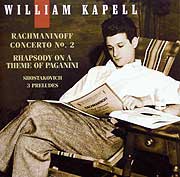 (27) was the other giant of the generation that arose at the end of Rachmaninoff's life (but whose own life was to be cut short a mere three years later). He revered Rachmaninoff as a "symbol of a pure and now completely decayed era of unabashed romanticism." Yet he applied his feelings by treading a middle road between the Katchen and Janis approaches, playing with ardor but respect. The second movement, especially, flows with controlled feeling and adds layers of understated interest without violating the basic Rachmaninoff premise. Empathetic accompaniment is provided by William Steinberg and the "Robin Hood Dell Orchestra" (a/k/a the Philadelphia, taking a summer vacation with RCA from their exclusive affiliation with arch-rival Columbia). (27) was the other giant of the generation that arose at the end of Rachmaninoff's life (but whose own life was to be cut short a mere three years later). He revered Rachmaninoff as a "symbol of a pure and now completely decayed era of unabashed romanticism." Yet he applied his feelings by treading a middle road between the Katchen and Janis approaches, playing with ardor but respect. The second movement, especially, flows with controlled feeling and adds layers of understated interest without violating the basic Rachmaninoff premise. Empathetic accompaniment is provided by William Steinberg and the "Robin Hood Dell Orchestra" (a/k/a the Philadelphia, taking a summer vacation with RCA from their exclusive affiliation with arch-rival Columbia).
An all-American hero, Van Cliburn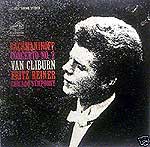 conquered Russia with his astounding victory in the 1958 Tchaikovsky Competition with the Rachmaninoff Third. A recording of his virile Carnegie Hall concert of that work days after returning home to a ticker-tape parade became a smash hit and prompted many critics to invoke comparisons with legendary past virtuosos, including Rachmaninoff himself. Yet Cliburn's Rachmaninoff Second, recorded in 1962 (when he was 27) with Fritz Reiner and the Chicago Symphony (RCA), seems curiously sterile, as his hugely expressive piano constantly chafes against and loses synch with the laidback straightforward accompaniment. Indeed, the ensemble lapses that afflict key moments, even ruining the culmination of the second movement, are atypical for Reiner's reputation as a precisionist. While some have described his approach in this work as monumental, it seems merely earthbound, taking flight only in the solo episodes. conquered Russia with his astounding victory in the 1958 Tchaikovsky Competition with the Rachmaninoff Third. A recording of his virile Carnegie Hall concert of that work days after returning home to a ticker-tape parade became a smash hit and prompted many critics to invoke comparisons with legendary past virtuosos, including Rachmaninoff himself. Yet Cliburn's Rachmaninoff Second, recorded in 1962 (when he was 27) with Fritz Reiner and the Chicago Symphony (RCA), seems curiously sterile, as his hugely expressive piano constantly chafes against and loses synch with the laidback straightforward accompaniment. Indeed, the ensemble lapses that afflict key moments, even ruining the culmination of the second movement, are atypical for Reiner's reputation as a precisionist. While some have described his approach in this work as monumental, it seems merely earthbound, taking flight only in the solo episodes.
Among the Russians, who presumably have a close affinity to Rachmaninoff and something special to say about his music, Vladimir Ashkenazy released two magnificent and remarkably similar recordings (thus suggesting that he was the driving interpretive force behind them both, much as Bernstein shaped his two readings). His first, with Kiril Kondrashin and the Moscow Philharmonic (Decca, 1962) when he was 25, has only slightly more pointed accompaniment and moderately less characterful solo playing than his 1972 remake with André Previn and the London Symphony (which, perhaps more than any other, is cited as the supreme paradigm of Rachmaninoff Seconds). In a typically Russian gesture, Ashkenazy creates emphases by slowing down and softening the tone rather than plunging forward. The ensembles are rich and full-blooded, underlining the extraordinary blend of textures between the sustained string and wind lines and the essentially percussive piano, which Rachmaninoff tended to finesse with solo arpeggios that often extend through the sections of orchestral display. who presumably have a close affinity to Rachmaninoff and something special to say about his music, Vladimir Ashkenazy released two magnificent and remarkably similar recordings (thus suggesting that he was the driving interpretive force behind them both, much as Bernstein shaped his two readings). His first, with Kiril Kondrashin and the Moscow Philharmonic (Decca, 1962) when he was 25, has only slightly more pointed accompaniment and moderately less characterful solo playing than his 1972 remake with André Previn and the London Symphony (which, perhaps more than any other, is cited as the supreme paradigm of Rachmaninoff Seconds). In a typically Russian gesture, Ashkenazy creates emphases by slowing down and softening the tone rather than plunging forward. The ensembles are rich and full-blooded, underlining the extraordinary blend of textures between the sustained string and wind lines and the essentially percussive piano, which Rachmaninoff tended to finesse with solo arpeggios that often extend through the sections of orchestral display.
And from the latest generation of pianists who have recorded the Rachmaninoff Second,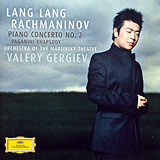 we have two extraordinary examples, each conducted by Valery Gergiev. Lang Lang, 22 years old at the time of his 2004 recording with the Mariinsky Theatre Orchestra (DG), announces his approach from the very outset with extremely deep, measured, rumbling chords that evoke somber bells. They launch a severely compressed recording that literally pushes the orchestra into the background and keeps the focus on the soloist, whose portraits fill the booklet and whose style is a throwback to the deeply inflected manner of Gieseking/Mengelberg, with huge rhythmic fluctuation in nearly every ripe romantic phrase, we have two extraordinary examples, each conducted by Valery Gergiev. Lang Lang, 22 years old at the time of his 2004 recording with the Mariinsky Theatre Orchestra (DG), announces his approach from the very outset with extremely deep, measured, rumbling chords that evoke somber bells. They launch a severely compressed recording that literally pushes the orchestra into the background and keeps the focus on the soloist, whose portraits fill the booklet and whose style is a throwback to the deeply inflected manner of Gieseking/Mengelberg, with huge rhythmic fluctuation in nearly every ripe romantic phrase,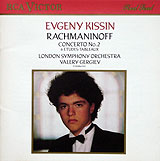 but here the orchestra can do little more than try to keep up, creating an extreme lack of cohesion that some will find exhilarating and fascinating (and even political – a bold soloist taming an entire social organism to his will) while others will dismiss the attempt as merely sloppy and incoherent. Indeed, I can’t recall a recent major-league recording that was so consistently savaged by critics. In defense of their broad 36½ minute pacing, Gergiev hails Lang's knowledge "that the composer wants the artist to take time to enjoy the piece." Yet we know from Rachmaninoff’s own 30½ minute recording that he preferred a far faster and steadier reading. Equally provocative but far less controversial is Evgeny Kissin, a mere 16 when he cut his 1988 CD with the London Symphony (RCA). Perhaps because of his tender age his approach is far less iconoclastic yet brims with the bold assertiveness of youth. The pairing with Gergiev is propitious. Both are imbued with quintessentially Russian spirit, have been widely hailed as the most exciting among their peers and boast a growing catalog of electrifying recordings. Although their timings are closer to Lang's than Rachmaninoff's, Kissin and Gergiev project a sense of ecstatic discovery of a masterpiece, and the bright, detailed sonics add a sense of having scrubbed clean the impasto of past ages of interpretation to permit the composer’s conception to shine anew. but here the orchestra can do little more than try to keep up, creating an extreme lack of cohesion that some will find exhilarating and fascinating (and even political – a bold soloist taming an entire social organism to his will) while others will dismiss the attempt as merely sloppy and incoherent. Indeed, I can’t recall a recent major-league recording that was so consistently savaged by critics. In defense of their broad 36½ minute pacing, Gergiev hails Lang's knowledge "that the composer wants the artist to take time to enjoy the piece." Yet we know from Rachmaninoff’s own 30½ minute recording that he preferred a far faster and steadier reading. Equally provocative but far less controversial is Evgeny Kissin, a mere 16 when he cut his 1988 CD with the London Symphony (RCA). Perhaps because of his tender age his approach is far less iconoclastic yet brims with the bold assertiveness of youth. The pairing with Gergiev is propitious. Both are imbued with quintessentially Russian spirit, have been widely hailed as the most exciting among their peers and boast a growing catalog of electrifying recordings. Although their timings are closer to Lang's than Rachmaninoff's, Kissin and Gergiev project a sense of ecstatic discovery of a masterpiece, and the bright, detailed sonics add a sense of having scrubbed clean the impasto of past ages of interpretation to permit the composer’s conception to shine anew.
If you love the Second Concerto, then you owe it to yourself to hear Rachmaninoff's gorgeous but sprawling 1907 Second Symphony, which perhaps is the only other of his works with comparable appeal of its overt emotionalism and magnificent melodies. 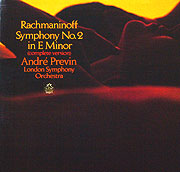 As with all his work, as Culshaw notes, the key to a great interpretation is extraordinary musicianship to navigate the delicate border between restraint and sentimentality. Unfortunately, Rachmaninoff never got to record his Second Symphony, but Dimitri Mitropoulos, whom he greatly admired, made a fine 1947 version (albeit heavily cut to 44 minutes) with his Minneapolis Symphony Orchestra (now on a Lys CD) that brilliantly balances discipline and ardent yearning to yield smoldering intensity. A 1958 Columbia stereo version by Eugene Ormandy and his Philadelphia Orchestra (to both of whom Rachmaninoff dedicated his final major work, the 1940 Symphonic Dances) runs to 48 minutes and overflows the bounds of controlled passion with the full sonic richness of that famed ensemble. In the meantime, a 1956 54-minute version by Kurt Sanderling and the Leningrad Philharmonic (DG) restored most of the others' cuts and sustained interest throughout its longer duration with a fine blend of empathy and clarity. Finally in 1972 André Previn and the London Symphony released an hour-long recording of the full score (EMI), unfolding the full splendor of the conception with inexorable emotional logic (and for its American release on the Angel label ensuring its sales appeal with a frankly erotic cover). As with all his work, as Culshaw notes, the key to a great interpretation is extraordinary musicianship to navigate the delicate border between restraint and sentimentality. Unfortunately, Rachmaninoff never got to record his Second Symphony, but Dimitri Mitropoulos, whom he greatly admired, made a fine 1947 version (albeit heavily cut to 44 minutes) with his Minneapolis Symphony Orchestra (now on a Lys CD) that brilliantly balances discipline and ardent yearning to yield smoldering intensity. A 1958 Columbia stereo version by Eugene Ormandy and his Philadelphia Orchestra (to both of whom Rachmaninoff dedicated his final major work, the 1940 Symphonic Dances) runs to 48 minutes and overflows the bounds of controlled passion with the full sonic richness of that famed ensemble. In the meantime, a 1956 54-minute version by Kurt Sanderling and the Leningrad Philharmonic (DG) restored most of the others' cuts and sustained interest throughout its longer duration with a fine blend of empathy and clarity. Finally in 1972 André Previn and the London Symphony released an hour-long recording of the full score (EMI), unfolding the full splendor of the conception with inexorable emotional logic (and for its American release on the Angel label ensuring its sales appeal with a frankly erotic cover).
Also of interest should be Rachmaninoff's 1909 Third Concerto, which he preferred to the Second as lying more comfortably under his admittedly huge hands. 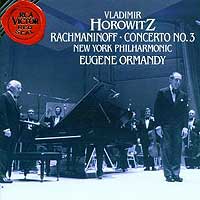 Other pianists, lacking his span, consider it far more challenging, even before the movie Shine cemented that image as a pop phenomenon with the masses. Rachmaninoff recorded a fine but heavily cut Third with Ormandy and the Philadelphia in 1939 but felt that the work was owned by Horowitz, whose three versions are all wonderful – a headstrong 1930 set of 78s with Albert Coates and the London Symphony (the work's phonographic premiere), a 1950 LP with Reiner and the Chicago Symphony, and a 1978 concert with Ormandy and the New York Philharmonic. The last had special resonance – the reclusive master returned to Carnegie Hall for his Golden Jubilee concert, marking both his first orchestral concert in 25 years and the fiftieth anniversary of his American premiere at which he first had astounded Rachmaninoff (and who rehearsed the Third with him in the Steinway basement), and featuring the work that had launched his fabulous career when he played it as his graduation piece from the Kiev Conservatory. Among many other fine accounts, the 1958 Cliburn concert – also a landmark occasion – remains thrilling. Other pianists, lacking his span, consider it far more challenging, even before the movie Shine cemented that image as a pop phenomenon with the masses. Rachmaninoff recorded a fine but heavily cut Third with Ormandy and the Philadelphia in 1939 but felt that the work was owned by Horowitz, whose three versions are all wonderful – a headstrong 1930 set of 78s with Albert Coates and the London Symphony (the work's phonographic premiere), a 1950 LP with Reiner and the Chicago Symphony, and a 1978 concert with Ormandy and the New York Philharmonic. The last had special resonance – the reclusive master returned to Carnegie Hall for his Golden Jubilee concert, marking both his first orchestral concert in 25 years and the fiftieth anniversary of his American premiere at which he first had astounded Rachmaninoff (and who rehearsed the Third with him in the Steinway basement), and featuring the work that had launched his fabulous career when he played it as his graduation piece from the Kiev Conservatory. Among many other fine accounts, the 1958 Cliburn concert – also a landmark occasion – remains thrilling.
Also hugely popular is the 1934 Rhapsody on a Theme of Paganini for piano and orchestra. The composer cut the first recording with Stokowski and the Philadelphia the year after its premiere. Since then, many of his concerto LPs and CDs come paired with this work. Essentially a set of brilliant variations on the famous theme from Paganini's last Caprice, the Rhapsody, more than any other of Rachmaninoff's works, combines the monumentality of his often disparaged concerto and symphonic writing with his universally acclaimed special gifts as a miniaturist.
Fortunately, there are two wonderful books about Rachmaninoff. Sergei Bertensson and Jay Leyda's Sergei Rachmaninoff – a Lifetime in Music (NYU Press, 1956) creates a living portrait with abundant quotes from Russian sources, including associates and family. Barrie Martyn's Rachmaninoff – Composer, Pianist, Conductor (Scolar Press, 1990)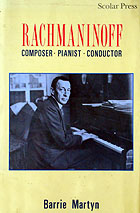 contains separate overviews of each of the three areas of Rachmaninoff's career, discusses each composition without getting bogged down in technicality, and is enhanced with thorough lists of his solo and orchestral repertoire, piano and orchestral concerts, recital programs and recording sessions. Plus you just gotta love a book where the back jacket flap eschews the usual flowery bio or scholarly credentials to merely state that the author is a retired school teacher! contains separate overviews of each of the three areas of Rachmaninoff's career, discusses each composition without getting bogged down in technicality, and is enhanced with thorough lists of his solo and orchestral repertoire, piano and orchestral concerts, recital programs and recording sessions. Plus you just gotta love a book where the back jacket flap eschews the usual flowery bio or scholarly credentials to merely state that the author is a retired school teacher!
Oskar von Reisemann's 1934 Rachmaninoff's Recollections (Books for Libraries Press, 1970 reprint) presents a special case. It seems like prime source material, as the author crafts lengthy quotations into a logical and empathetic first-person account that provides unique glimpses into the normally reticent composer's thoughts. As a preface to his book, he prints a 1933 letter in which Rachmaninoff cites their long and close friendship and thanks him for his sympathetic understanding of their intimate talks. Yet, Bertensson and Leyda claim that Rachmaninoff recalled that Reisemann never took any notes during their walks, was shocked at the title, and considered most of the "recollections" to have been fabricated, but felt sorry for the author after a heart attack. Yet, even after paying to have the book heavily edited, he still disowned it.
Briefer character portraits are available in John Culshaw's Rachmaninoff – the Man and His Music (Oxford University Press, 1950) and Abram Chasin's essay "As I Saw Rachmaninoff," included as an insert booklet in the first RCA LP box (LM-6123) of the composer's own recordings of the four piano concertos and the Paganini Rhapsody.

Copyright 2007 by Peter Gutmann
|

